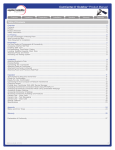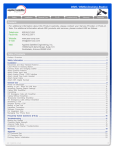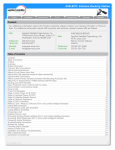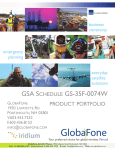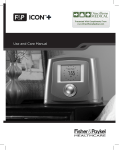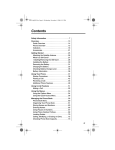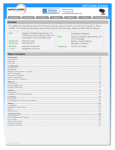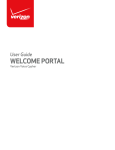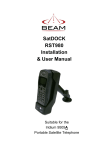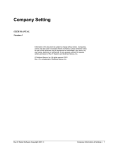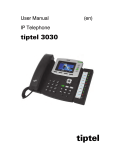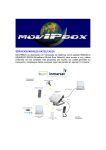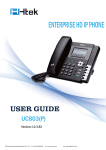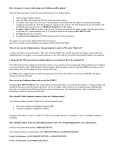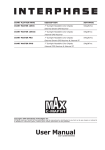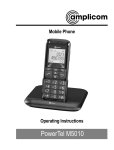Download ASE Comcenter Indoor (MC08) User`s Manual
Transcript
ASE ComCenter II Safety Models Overview Installation Testing Settings Use Special Specs TroubleShoot Warranty Appendix Contacts For additional information about this Product warranty, please contact your Service Provider or Point-ofSale. For additional information about ASE products and services, please contact ASE as follows: Mail: Telephone: Facsimile: Website: E-mail: Applied Satellite Engineering, Inc. 16559 North 92nd Street, Suite 101 Scottsdale, Arizona 85260 USA 480.443.1424 480.452.0971 www.ase-corp.com [email protected] Mail: Telephone: International Branch Applied Satellite Engineering, Intl. 46 An Leac Lian Barna, County Galway Ireland 353 85 761 5506 Table of Contents Safety Information ................................................................................................................................................................................3 Preface / Overview ...................................................................................................................................................................................5 Models .....................................................................................................................................................................................................6 Installation ..............................................................................................................................................................................................8 Mounting your Fixed Station Terminal ....................................................................................................................................................8 Wall Mounting ...........................................................................................................................................................................................8 Swivel Mounting Kit ...................................................................................................................................................................................8 Common Wire Connections ......................................................................................................................................................................9 Attach External Antenna ...........................................................................................................................................................................9 Attach Power Jack .....................................................................................................................................................................................9 Attach to POTS / RJ-11 ..........................................................................................................................................................................10 Attach Privacy Privacy Handset ..............................................................................................................................................................10 Connecting to your computer or Network ...........................................................................................................................................11 Changing Modes ....................................................................................................................................................................................11 Finding your Device with ASE Device Manager .....................................................................................................................................12 Changing Ethernet Connections ..........................................................................................................................................................13 Testing .....................................................................................................................................................................................................15 Checking Signal Strenth and Satellite Visibility .....................................................................................................................................15 POTS / RJ-11 Voice Connection .......................................................................................................................................................15 Privacy Handset Voice Connection .......................................................................................................................................................15 Data Connection ....................................................................................................................................................................................16 Accessing System Settings ....................................................................................................................................................................16 Settings ..................................................................................................................................................................................................17 Accessing ComCenter II Settings .........................................................................................................................................................17 Use .........................................................................................................................................................................................................18 General Use - Voice Calls ........................................................................................................................................................................18 General Use - Text Messaging ................................................................................................................................................................19 General Use - Data Calls .........................................................................................................................................................................19 Special Features ..................................................................................................................................................................................20 Specifications .......................................................................................................................................................................................23 Troubleshooting ...................................................................................................................................................................................24 Installation and Startup Troubleshooting .............................................................................................................................................24 Status and Error Tones .........................................................................................................................................................................25 Warranty ................................................................................................................................................................................................26 Appendix ...............................................................................................................................................................................................28 Using Iridium’s Messaging Features .............................................................................................................................................28 Declaration of Conformity .......................................................................................................................................................................51 Rev 1.1 [01-09-12] 1 ASE ComCenter II Safety Overview Models Installation Testing Settings Use Special Specs TroubleShoot Warranty Appendix PRECAUTIONS: Please read and understand this User’s Manual before installing your ComCenter II. Careless or incorrect installation can degrade performance, damage both new and existing equipment, and incur unexpected network airtime charges. Safety Information 1. FAA Regulations ASE products are not FAA-approved and are not intended for aircraft use. 2. Exposure to Radio Frequency Signals Your Iridium-designed satellite unit is a low power radio transmitter and receiver. When it is ON, it receives and sends out radio frequency (RF) signals. International agencies have set standards and recommendations for the protection of public exposure to RF electromagnetic energy: • International Commission on Non-Ionizing Radiation Protection (ICNIRP) 1996 • Verband Deutscher Elektrotechniker (VDE) DIN-0848 • United States Federal Commission, Radio Frequency Exposure Guidelines (1996) • National Radiological Protection Board of the United Kingdom, GS 11, 1988 • American National Standards Institute (ANSI) IEEE C95, 1-1992 • National Council on Radiation Protection and Measurements (NCRP) Report 86 • Department of Health and Welfare Canada, Safety Code 6 These standards are based on extensive scientific review. For example, over 120 scientists, engineers, and physicians from universities, government health agencies, and industry reviewed the available body of research to develop the updated ANSI standard. The design of your phone complies with these standards when used as described under “Unit Operation.” 3. Antenna Care Use only the antenna supplied by your service provider or an approved replacement antenna. Unauthorized antennas, modifications, or attachments could degrade performance or damage the phone and may violate local agency regulations. 4. Unit Operation Do not operate the unit when a person is within 4 inches (10 centimeters) of the antenna. A person or object within 4 inches (10 centimeters) of the antenna could impair call quality and may cause the unit to operate at a higher power level than necessary and expose that person to RF energy in excess of that established by the FCC RF Exposure Guidelines. 5. Driving Check the laws and regulations on the use of wireless telephones in the areas where you drive. Always obey them. Observe the following guidelines when using your phone while driving: •Give full attention to driving; driving safely is your first responsibility. •Use hands-free phone operation, if available. •Pull off the road and park before making or answering a call if driving conditions so require. Rev 1.1 [01-09-12] 2 ASE ComCenter II Safety Overview Models Installation Testing Settings Use Special Specs TroubleShoot Warranty Appendix Safety Information (Continued) 6. Electronic Devices Most modern electronic equipment is shielded from RF signals. However, certain equipment may not be shielded against RF signals from your Iridium-designed satellite unit. 7. Pacemakers The Health Industry Manufacturers Association recommends that a minimum separation of 6 inches be maintained between a wireless phone’s antenna and a pacemaker to avoid potential interference with the pacemaker. These recommendations are consistent with the independent research by and recommendations of Wireless Technology Research. PERSONS WITH PACEMAKERS • • Should ALWAYS keep the Iridium-designed satellite unit more than six inches from their pacemaker when the unit is turned ON. Should turn the unit OFF immediately if you have any reason to suspect that interference is taking place. 8. Other Medical Devices If you use any other personal medical device, consult the manufacturer of your device to determine if it is adequately shielded from external RF energy. Your physician may be able to assist you in obtaining this information. Turn your unit OFF in health care facilities when any regulations posted in these areas instruct you to do so. Hospitals or health care facilities may be using equipment that could be sensitive to external RF energy. 9. Vehicles RF signals may affect improperly installed or inadequately shielded electronic systems in motor vehicles. Check with the manufacturer or its representative regarding your vehicle. You should also consult the manufacturer of any equipment that has been added to your vehicle. 10. Posted Facilities Turn your unit OFF in any facilities where posted notices so require. 11. Blasting Areas To avoid interfering with blasting operations, turn your unit OFF when in a “blasting area” or in areas posted “Turn off two-way radio.” Obey all signs and instructions. 12. Potentially Explosive Atmospheres Turn your unit OFF and disconnect the power supply when you are in any area with a potentially explosive atmosphere. Obey all signs and instructions. Sparks from your battery or power source in such areas could cause an explosion or fire resulting in bodily injury or even death. Areas with a potentially explosive atmosphere are not always clearly marked. They include, but are not limited to: fueling areas such as gasoline stations; below deck on boats; fuel or chemical transfer or storage facilities; areas where fuel odors are present (for example, if a gas/propane leak occurs in a car or home); areas where the air contains chemicals or particles, such as grain, dust, or metal powders; and any other area where you normally would be advised to turn off your vehicle engine. Rev 1.1 [01-09-12] 3 ASE ComCenter II Safety Overview Models Installation Testing Settings Use Special Specs TroubleShoot Warranty Appendix Safety Information (Continued) 13. For Vehicles Equipped With Airbags An air bag inflates with great force. Do NOT place objects, including both installed or portable wireless equipment, in the area over the air bag or in the air bag deployment area. If in-vehicle wireless equipment is improperly installed and the air bag inflates, serious injury could result. 14. Important Notes for PABX System Users If using the ComCenter II with a PABX system, the following precautions must be followed to prevent damage to your unit. The ComCenter II emulates a standard land-line wall jack and generates the required operating and ringing voltages. Connect to a PABX as either a central office (CO) or trunk line. Never connect the ComCenter II to a PABX as an extension or damage to the PABX or ComCenter II may result. Rev 1.1 [01-09-12] 4 ASE ComCenter II Safety Overview Models Installation Testing Settings Use Special Specs TroubleShoot Warranty Appendix Product Overview The ComCenter II Series brings your Iridium satellite link indoors to provide secure data and/or voice communication anywhere in the world. This new series includes an Ethernet interface allowing IP-addressable network connectivity for global satellite data transfer and remote system control. Ethernet connectivity brings you unprecedented new features like ASE SatChat SMS messaging and M2M Port Forwarding. These versatile and enhanced voice and data features make the ComCenter II the ideal solution for a wide variety of remote communications applications. ENHANCED VOICE • RJ-11 (POTS) for PABX, standard phones, or wireless base station • RJ-45 Intelligent Privacy Handset interface for voice or texting • SmartDial simplified dialing sequence • Audio Status Tones ENHANCED DATA • Ethernet connectivity provides versatile IP-based satellite data interface • IP Port Forwarding for machine-to- machine (M2M) and VSAT Diagnostics • Configurable periodic reports ensure and enhance overall system resilience • GPS option with configurable periodic reports provides low-cost tracking solution • Third Party Apps: e-mail, weather info, blogs ENHANCED EXTRAS • SMS TEXTING with Embedded ASE SatChat • Real-time diagnostic, event, and call logs • Crew calling and scratch card support • Highly visible status indicators • Built-in audible ringer • Wide operating range: 10-36VDC • Universal AC/DC and Vehicle DC power adapters included Rev 1.1 [01-09-12] 5 ASE ComCenter II Safety Overview Models Installation Testing Settings Use Special Specs TroubleShoot Warranty Appendix Simple System Setup and Verification Installation of the ComCenter II is simple and easy. Once installed, the ComCenter II can be easily configured and tailored to your application by accessing settings 3 different ways; 1. POTS/RJ-11 via setup commands. 2. Privacy Handset via setup commands. 3. Embedded webpage via mouse clicks and dialog boxes. System verification, operation and status details are available in 4 ways; 1. Highly visible LED indicators. 2. Audible tones on the POTS/RJ-11 interface. 3. Text messages on the Privacy Handset LCD display. 4. Embedded webpage settings and diagnostics. Rev 1.1 [01-09-12] 6 ASE ComCenter II Safety Overview Models Installation Testing Settings Use Special Specs TroubleShoot Warranty Appendix Models and Configurations To meet various applications and system installations, the ComCenter II is available in two main configurations, each with optional configurations and accessories; Voice and Data – Model ASE-MC08 This model does it all! Voice, Data, and SMS Texting. Perfect for Resilience, business continuity, corporate communications with remote personnel, data backup, and VSAT back door control. Data Only – Model ASE-MC07 Model ASE-MC07 is a lower-cost, reduced feature model that eliminates voice interfaces and features and targets data-only applications. The Ethernet port allows network connectivity for global satellite data transfer and remote system control. Perfect for Resilience, data backup, and VSAT back door control. Optional Configurations and Accessories; Integrated GPS Model ASE-MC0xG Rev 1.1 [01-09-12] Swivel RAM Mount with Privacy Handset Model ASE-MC0x-H 7 ASE ComCenter II Safety Overview Models Installation Installation Testing Settings Use Special Specs TroubleShoot Warranty Appendix Installation and General setup IMPORTANT: For proper operation, the SIM card installed in your ComCenter II must be ACTIVATED (by your Service Provider) and UNLOCKED (pin code turned off). If the PIN code has not been turned off by your Service Provider, refer to Accessing ComCenter II Settings for a command to turn it off. Note that for security reasons, the ComCenter II can only turn off the Iridium default PIN code. Mounting your Fixed Station Terminal Every installation is unique, and as such, ASE has provided a number of alternate mounting configurations. Additional hardware may be developed in the future that is not illustrated in this manual. Please contact an ASE representative or your local reseller for more information. IMPORTANT: If you are in doubt about the mounting steps or the connectivity at any stage of this installation, please contact an ASE representative for assistance. They will be able to guide you through your specific installation options more clearly. Wall Mounting First position the device at the proper height and then mark the screw locations using a pencil. Next, anchor the mounting screws on the wall leaving about 0.25” of the head exposed. Hang the device on the exposed screw heads and then tighten until snug. IMPORTANT: Different wall materials require different mounting hardware, The proper screws / anchors should be selected according to the materials used on your wall. Swivel Mounting (optional kit compatible with all models) First Affix the Round Base to a sturdy surface using anchors and/or screws as appropriate for the material. Next Attach the ComCenter II to the Mounting Plate using the center keyholes. Finally, plug the privacy Handset into the ComCenter II for use. IMPORTANT: Different wall materials require different mounting hardware, The proper screws / anchors should be selected according to the materials used on your wall. Rev 1.1 [01-09-12] 8 ASE ComCenter II Safety Overview Models Installation Testing Settings Use Special Specs TroubleShoot Warranty Appendix Common Wire Connections You may not need to make every accessory connection that you see outlined on the following pages. However, the steps shown on this page are generally the most common and should be read carefully. IMPORTANT: If you are in doubt about the mounting options or the connectivity at any stage of this installation, please contact an ASE representative for assistance. They will be able to guide you through your specific installation options more clearly. Attach External Antenna The ComCenter II accepts a male TNC connector. Screw the antenna cable on to the ComCenter II and tighten securely. IMPORTANT: Do not exceed cable lengths outlined in the troubleshooting section of this manual. Keep cable splices to a minimum. Attach Power Input Jack Align the pin of the cord with the receptacle and press the plug firmly in place. Next twist the collar to “lock” the cord to the ComCenter II. IMPORTANT: The Lock collar on this cable should only be tightened “finger-tight”. Do not use pliers as this will overtighten the cable and potential damage the connector housing. Rev 1.1 [01-09-12] 9 ASE ComCenter II Safety Overview Models Installation Testing Settings Use Special Specs TroubleShoot Warranty Appendix Optional Accessory Connections The following connections are optional and may not apply to every installation Connecting to POTS/RJ-11 (Model ASE-MC08 Only) WARNING TO PABX System USERS: If using the ComCenter II with a PABX system, the following precautions must be followed to prevent damaging your unit. The ComCenter II emulates a standard land line wall jack and generates the required operating and ringing voltages. Connect the PABX as either a central office (CO) or trunk line. Never connect the ComCenter II to a PABX as an extension or damage to the PABX and/or ComCenter II may occur. Single Analog Phone or Base Station with Wireless Handsets Connect your optional RJ-11/POTS equipment to this port. Typical equipment used with the ComCenter II include; • • • Single analog phone or office speakerphone Base station with wireless handsets PABX to corporate telecom infrastructure (see PABX connection warning) Attach Privacy Handset (Model ASE-MC08 Only) Connect your Privacy Intelligent Handset to the RJ-45 jack as shown. The plug should be pressed into the socket until an audible ‘click’ is heard; this indicates the plug is fully seated and locked in position. IMPORTANT: This port uses a common RJ45 connector, but it should be noted that it will NOT support a connection to anything other than an Privacy Intelligent Handset. Additionally, only one handset is supported. Rev 1.1 [01-09-12] 10 ASE ComCenter II Safety Overview Models Installation Testing Settings Use Special Specs TroubleShoot Warranty Appendix CONNECTING TO YOUR COMPUTER OR NETWORK VIA ETHERNET (RJ-45) The ComCenter II’s Ethernet port provides a powerful IP-addressable data connection to your local area network (LAN) or directly to your computer. For maximum connection flexibility, the ComCenter II supports the following connection options; 1. DIRECT or fixed IP address for advanced users. 2. DHCP CLIENT for automatic network integration (default). 3. DHCP SERVER for direct PC or Laptop connection. DIRECT MODE For single node or networks with fixed IP addresses The direct mode allows you to manually assign a fixed IP address to the ComCenter II. The ComCenter II’s default IP address is 192.168.1.100 but can be changed if needed. Direct mode is typically for advanced users who need to assign specific IP addresses to support their network configuration. DHCP CLIENT MODE For multi-node networks that have a DHCP server (router) This is the most common network connection mode. You connect the ComCenter II to your network like any other Ethernet device and it gets assigned an IP address automatically. This is typically done by an Ethernet router in the network that also provides this DHCP server function. DHCP SERVER MODE For single node / multi-node networks w/o a router or other DHCP server In this mode, the ComCenter II assigns IP addresses to network peripherals, normally done by an Ethernet router, and retains its own default IP address of 192.168.1.100. This mode is a convenient way to connect directly to a laptop without the need for a router. CHANGING MODES The default mode is DHCP Client but can be changed in a number of ways; 1. With the reset button located on the ComCenter II’s connector panel. 2. Entering codes with the Privacy Handset. 3. Entering codes with the connected POTS/RJ-11 equipment. 4. Clicking on the desired mode via the embedded webpage. Rev 1.1 [01-09-12] 11 ASE ComCenter II Safety Overview Models Installation Testing Settings Use Special Specs TroubleShoot Warranty Appendix Finding your ComCenter II with ASE Device Manager The ASE Device Manager utility is included with your ComCenter II on CD-ROM. Install on your host computer and let the ASE Device Manager simplify your network installation. Simply click the FIND button and the ASE Device Manager will scan your network for ASE Devices. Found device(s) will then be listed in the drop-down Profile box. You can now select the device from the profile box and open its unique webpage to access its data features, or connect your PC to the Internet directly through the device. Rev 1.1 [01-09-12] 12 ASE ComCenter II Safety Overview Models Installation Testing Settings Use Special Specs TroubleShoot Warranty Appendix Changing the Ethernet Connection Mode Using the Panel Button: Initial press of the panel button will display the current mode by blinking all 4 status LEDs on the ComCenter II to indicate the mode setting. 1 Blink = DIRECT (ComCenter uses fixed IP address 192.168.1.100) 2 Blinks = DHCP Client (factory default, your network assigns IP address) 3 Blinks = DHCP Server (ComCenter assigns IP address to clients and sets self to 192.168.1.100) Pressing and releasing the button will indicate and retain the current mode setting. Pressing and holding the button will sequence through each mode. Release the button when the blink pattern matches the desired mode. Unit will reboot with this new setting. Press and release the button to confirm your mode setting is correct. Changing the Ethernet Connection Mode Using Privacy Handset: Remove from hang-up cup and press the following keys (each command begins with the star (*) character); *610 = DIRECT (1 blink) *611 = DHCP Client (2 blinks) *612 = DHCP Server (3 blinks) When changing modes with the Privacy Handset, the display on the Privacy Handset will show the mode setting and the status LEDs will also blink to indicate the mode setting. ADDITIONAL USEFUL COMMANDS USING THE PRIVACY HANDSET *994 displays current mode setting and blinks the status LEDs accordingly. *955 displays current IP address setting. Rev 1.1 [01-09-12] 13 ASE ComCenter II Safety Overview Models Installation Testing Settings Use Special Specs TroubleShoot Warranty Appendix Changing the Ethernet Connection Mode Using POTS/RJ-11: The same commands are used with the POTS/RJ-11 as with the Privacy Handset. However, because there is no display of information on the POTS/ RJ-11, watch the blink pattern on the status LEDs and listen to audible beeps to confirm the mode setting. To change mode, take the POTS/RJ-11 phone off-hook and press the following keys; *610 = DIRECT (1 blink, 1 beep) *611 = DHCP Client (2 blinks, 2 beeps) *612 = DHCP Server (3 blinks, 3 beeps) Additional useful commands using POTS/RJ-11; *994 blinks the status LEDs and gives audible beeps according to mode setting. Changing the Ethernet Connection Mode Using Embedded Webpage: Accessing the embedded webpage in the ComCenter II may not be possible unless the default DHCP Client mode is compatible with your specific network. Once you are able to access the ComCenter II’s webpage, the mode can be changed by clicking on the CONFIGURE button. This page will allow you to change modes. CAUTION: changing modes will likely cause you to lose access to the webpage until the network or direct connection is also configured to this new mode. Rev 1.1 [01-09-12] 14 ASE ComCenter II Safety Overview Models Installation Testing Settings Use Special Specs TroubleShoot Warranty Appendix Testing your setup After installation and applying power, the ComCenter II’s visual and audible indicators let you know status and health of your overall system. Checking Signal Strength and Satellite Visibility With proper antenna installation and visibility to the Iridium constellation, the ComCenter II’s GREEN satellite indicator will be illuminated and on solid (not blinking). Allow 5 to 10 minutes after power is first applied for system initialization and network registration. The ComCenter II’s embedded webpage also includes event logs and real-time diagnostics that are useful for monitoring system operation and checking signal strength during installation and over time. See the troubleshooting section if this indicator continues to blink or blinks periodically. IMPORTANT: Iridium’s low earth orbit satellite constellation requires antennas to have a 360° view of the sky with no obstructions 8.2° above the horizon in any direction. POTS/RJ-11 Voice Connection When the optional POTS connected equipment goes off-hook, a dial tone will be present indicating the system is operating properly and a call can be placed. Otherwise, a busy signal or other error tone sequence will be present. The blue phone LED indicator will also light when a voice call is in process. Privacy Handset Voice Connection Text messages on the optional Privacy Handset’s display provides system status. When READY is displayed, the system is ready to make a call. Remove the Privacy Handset from the hang-up cup and a dial tone will be present and a call can be placed. The blue phone LED indicator will also light when a voice call is in process. Rev 1.1 [01-09-12] 15 ASE ComCenter II Safety Overview Models Installation Testing Settings Use Special Specs TroubleShoot Warranty Appendix Data Connection The ComCenter II contains an embedded webpage that provides system status info as well as diagnostic utilities. The status bar will say READY when the system is operating properly and a data connection can be established. Clicking the CONNECT button will automatically dial Iridium’s ISP and establish a PPP connection. Once connected, the status bar will say ON LINE, the blue data LED indicator on the ComCenter II will light, and the CONNECT button will change to DISCONNECT. Click the DISCONNECT button to terminate the data session. Accessing System Settings System settings can be accessed and changed in several ways to allow access depending on what interface(s) you are using. Changeable settings include; SmartDial 911 USA Crew ID protected access Captain’s card installed Periodic reporting Base station ringer volume adjust or disable Voice volume adjust (POTS/RJ11 access only) Event log and diagnostic monitoring (embedded webpage only) Restore to factory defaults The embedded webpage provides simple selection and dialog boxes for easy setting changes. Both the POTS/RJ-11 and Privacy Handset interfaces provide numeric commands to change settings as shown in the following table. Rev 1.1 [01-09-12] 16 ASE ComCenter II Safety Overview Installation Models Testing Settings Settings Use Special Specs TroubleShoot Warranty Appendix Accessing ComCenter II Settings (RJ-11 and privacy intelligent handset) OPTION Volume SEQUENCE * 20 DESCRIPTION 1 2 3 4 5 Lowest Press *20 and then press 1 through 5 to change the volume level sent to the handset. Press 1 to adjust the volume to its lowest level, and 5 to adjust it to its highest. Highest US 911 * 50 0 1 Disabled Enabled Press *500 to toggle USA 911 dialing off and *501 to toggle it on. By default the ComCenter II is set to USA 911 On. We strongly recommend leaving 911 dialing on if you are a United States customer. Be sure to read the sections below discussing emergency 911 calls. This setting partially overrides SmartDial recognition of country codes and allows United States callers to simply type 911 to access the emergency system. (If this setting is off, then calls starting with “91” are recognized as dialing the country code for India.) Network Loss Alert * 51 0 1 Disabled Enabled Press *510 to turn off network loss alert (system default setting). Press *511 to turn on network loss alert. ComCenter II speaker will beep whenever satellite network is lost or restored. Off Low Med High Press *52, and then the volume setting you prefer for the base station ringer. Pressing *520 will silence the ringer for incoming calls but will not affect equipment connected to the RJ-11 port. They will still ring even with the base station ringer disabled. Base Station Ringer * 5 2 0 1 2 3 Captain’s Sim * 53 0 1 Disabled Enabled Press *530 for standard SIM card. Press *531 for Captain’s SIM. Network Mode * 61 0 1 2 Direct Client Server Sets the network mode with 0 being DIRECT, 1 being DHCP Client and 2 being DHCP Server ### Press *7 to reach the Phone Book that resides in the SIM card, then enter the three-digit QuickDial number for the entry you wish to dial. Hang up to exit this menu. See the section below “Managing Your Phone Book” to learn more about this option. Phone Book * 7 , Firmware Version * 9 9 1 Displays the Dock model and version numbers on privacy handset Serial Number * 9 9 2 Displays the ComCenter II Serial Number on Privacy Handset IMEI * 9 9 3 Displays the Iridium IMEI number on the privacy handset Network Mode Turn PIN off Restore Defaults Rev 1.1 [01-09-12] 99 * * * 4 5 1 1 1 2 IP Mode Address 1 3 Unlocks SIM by turning the default Iridium PIN code off. The ComCenter II requires the PIN be turned off to access the satellites. 1 4 Press *994 to displays the Network IP Mode (Direct, DHCP Client or DHCP Server) Pressing *995 displays the Network IP Address, and blinks LEDs according to setting). 5 Restores default settings (excluding network settings) 17 ASE ComCenter II Safety Overview Models Installation Testing Settings Use Special Specs TroubleShoot Warranty Appendix General Use - Voice Calls (ASE-MC08 Only) ASE’s SmartDial technology makes dialing simple. SmartDial automatically identifies the country code and knows how many digits are required for that country code. Once the correct number of digits have been entered, dialing commences automatically. SmartDial de-activates itself when the standard ‘00’ Iridium dialing sequence is detected. Pressing “#” to send is then required to initiate the call. • Placing a call with POTS/RJ-11 Take the POTS/RJ-11 phone off-hook and listen for dial tone. When dial tone is present, simply enter the country code, area code, and phone number. SmartDial will automatically place the call when the correct number of digits are entered and you will hear the Iridium ‘boop’ sound until the call connects. Examples using SmartDial: USA call: 1(3-digit area code)(7-digit phone number) Iridium ISU call: 8816(8-digit phone number) Examples bypassing SmartDial: USA call: 011(3-digit area code)(7-digit phone number)(# to send) Iridium ISU call: 0118816(8-digit phone number)(# to send) • Answering a call with POTS/RJ-11 POTS/RJ-11 phone connected to the ComCenter II will automatically ring • Placing a call with Privacy Handset Remove Privacy Handset from hang-up cup and listen for dial tone. If • Answering a call with Privacy Handset The Privacy Handset will automatically ring when an incoming call is when an incoming call is pending. Simply take off-hook to answer. hang-up cup is not used, press the OK button to toggle it on and off hook. When dial tone is present, simply enter the country code, area code, and phone number. SmartDial will automatically place the call when the correct number of digits are entered and you will hear the Iridium ‘boop’ sound until the call connects. pending. To answer, remove Privacy Handset from hang-up cup and press the OK button. Rev 1.1 [01-09-12] 18 ASE ComCenter II Safety Overview Models Installation Testing Settings Use Special Specs TroubleShoot Warranty Appendix General Use - Text Messaging • Text messaging with ASE SatChat ASE’s powerful and convenient SatChat provides simple SMS text messaging dialogue from any Ethernet connected device such as network computers, wireless laptops, and even iPhones, and iPads. This included feature is available by accessing the ComCenter II’s embedded webpage and works similar to short email messages and blog dialogues. ASE Satchat messages can be sent to and received from other SMS enabled Iridium equipment and cell phones, as well as standard email addresses. • Text messaging with Privacy Handset (appendix) Remove the Privacy Handset from the hang-up cup and press the MENU button to access the Iridium-based SMS text messaging features. Note that the inherent Iridiumbased MENU features contained in the Privacy Handset follow the previous generation 9505A handset protocols and operate differently than the 9555 handset. See appendix for SMS messaging commands as they apply to the Privacy Handset. General Use - Data Calls The ComCenter II simplifies data connections via its embedded webpage. Depending on the type of connection, a simple button click from this webpage will initiate an Iridium PPP session or peer-to-peer connection. Port forwarding features are also available for advanced users. Rev 1.1 [01-09-12] 19 ASE ComCenter II Safety Overview Models Installation Testing Settings Use Special Specs TroubleShoot Warranty Appendix SPECIAL FEATURES POTS/RJ-11 PORT This port provides a versatile satellite link to the standard equipment you’re already familiar with. RJ-11 connected equipment can be located more than a mile away from the ComCenter II, solving antenna location problems and minimizing costly antenna runs. Besides being a voice link, this interface has the following additional features; · · · · VOICE CONNECT WITH SMARTDIAL. SmartDial simplifies satellite dialing sequences by converting familiar land line dialing to satellite dialing. But if you prefer satellite dialing, SmartDial will automatically detect and disable itself. PABX & WIRELESS BASE STATION. Typical RJ-11 applications include trunk line interface to standard multi-user PABX systems, base station with single or multiple wireless handsets, or a single analog phone powered entirely by the ComCenter II for resilience planning communications back up. ACCESS TO SYSTEM SETTINGS. ComCenter II system configuration and settings are accessible via this port. STATUS AND ERROR TONES. Since most RJ-11 connected equipment is located a great distance from the ComCenter II, specific audible tones let you know system status at all times. ETHERNET PORT This port opens up tremendous network and peripheral connection possibilities. Ethernet connection to the ComCenter II also gives you access to unique features and applications contained in its internal webpage. Features of this port include; · · · · · · · DATA CONNECT WITH ASE WEBPAGE. Use your favorite web browser to access the ComCenter II’s embedded webpage. Data connections from the ComCenter II’s webpage take just a simple click of the mouse. DIRECT & WIRELESS ROUTER CONNECT. Connect directly to a single computer, drop onto your network, or use a wireless router for optimum convenience. ASE SATCHAT. Simple yet powerful SMS text messaging application available from the embedded webpage. ASE PORT FORWARDING. This special feature requires two ComCenter IIs in most cases to easily solve difficult Iridium-linked M2M applications. Details are beyond the scope of this manual. Please contact ASE for more information. SECURITY PIN CODES. Another feature included in the embedded webpage is the option to set PIN codes to prevent unauthorized use. Voice and data access become disabled and the ComCenter II will then prompt the user for a valid PIN code. STATUS AND ERROR DISPLAY. The ComCenter II’s embedded webpage has a real time status bar showing current state of the system and Iridium network. ACCESS TO SYSTEM SETTINGS AND DIAGNOSTICS. ComCenter II system configuration and settings are accessible via the embedded webpage. This webpage also includes diagnostics and system logs useful for installation confirmation and general use stats. Rev 1.1 [01-09-12] 20 ASE ComCenter II Safety Overview Models Installation Testing Settings Use Special Specs TroubleShoot Warranty Appendix SPECIAL FEATURES (continued) EMBEDDED WEB PAGE As an extension of the Ethernet port, the ComCenter II provides unique and power features via its internal, embedded web pages. System information is displayed in the header of all web pages, including; system IMEI, Firmware Versions, Your Phone Number (see setting Your Phone Number below) and the current System Status. The Embedded web pages provide the following ASE special features; · · · · · · · · · · · · · · · · ASE SATCHAT: Provides SMS chatting service to other Iridium phones, email addresses or cell phones (check with cell phone provider for international support). ASE IRIDIUM-IRIDIUM CONNECT: Initiates an internet connection via the Iridium ISP. The ComCenter II will perform the dial-up and PPP authentication. Once status reports ONLINE you have established your Internet Connection. ASE COMCENTER SETUP: Provides system configuration including your phone number, periodic messages, configuration options, and user PIN codes. Further and advanced setup options are available if you proceed to the MODEM web-link. Note: When PIN Access Required is set to ON, access to this page requires one of the 10 user set PIN codes previously setup on this page. SAVE AND RESTORE: You must click save to accept all changes to the configuration. Restore will restore the factory default configuration. YOUR PHONE NUMBER: During installation of your ComCenter, enter Your Phone Number as a convenient method to store this number. PERIODIC MESSAGES: When configured can provide automatic, periodic messages to validate system status. For example, a message of “Emergency Communication System is OK” could be configured to be sent to [email protected] every week. Note: SMS messages incur extra airtime charge. Check with your airtime provider for more details. PIN ACCESS REQUIRED: [On | Off] Activates ComCenter II PIN codes as described below. HANDSET VOLUME: [5 Levels] RINGER IN BASE: [OFF | Low | Med | High] CAPTAINS CARD: [Yes | No] If your SIM card is the type called “Captain’s Card”, then this option must be set. USA 911: [On | Off] Allows 911 calls in US. Note: 911 conflicts with country code for India. If using SmartDial pattern for calls to India, the USA911 can be turned off. PIN CODES: These assigned PIN Codes allow Post-paid access to the Iridium service for systems using a SIM card type “Captain’s Card”. The PIN must be a 7-digit number. If fewer digits are stored, the system expects pre-pended 0’s to complete the 7-digits. For example: PIN 85260 would require entering 0085260 when accessing system. ASE PEER-TO-PEER: Provides Peer-to-Peer configuration and connection. Setup includes Dial-up number, or RAS (Remote Answer) enable, and Port Forwarding. SAVE : You must click save to accept all changes to the configuration. DIAL-UP NUMBER: This is the number of the device to be called when using this modem as the calling device (MO) when initiating a Peer-to-Peer session. RAS: Enable the Remote Answer Service in the modem when using this modem as the called device (MT) in a Peer-to-Peer session. Rev 1.1 [01-09-12] 21 ASE ComCenter II Safety Overview Models Installation Testing Settings Use Special Specs TroubleShoot Warranty Appendix SPECIAL FEATURES (continued) · · · · PORT FORWARDING: IP addresses within the local network of the remote site can be accessed using Port Forwarding by assigning local IP addresses to unique ports. The syntax is WanPort, Local IP address:Port. For example to allow port forward access to a web-server running on local device 192.168.1.52:80, the setup would be 80,192.1.52:80. ASE EVENT LOG: Displays a list of the last 100 system events. These events include phone usage and SMS usage. ASE NETWORK MONITOR: Updates list of signal strength and other system status information every 15 seconds. RESTART SYSTEM: Provides a mechanism for remote system reboot. PRIVACY HANDSET PORT This port supports and enhances Iridium’s Intelligent DPL Privacy Handset. This optional handset includes a latching hang-up cup and provides a secure, tethered Iridium connection that can be extended up to 25 feet with standard CAT5 cable. The ComCenter II enhances this handset with unique features including system status and error messages as well as system info and settings access. • • • • VOICE CONNECT WITH SMARTDIAL. SmartDial simplifies satellite dialing sequences by converting familiar land line dialing to satellite dialing. But if you prefer satellite dialing, SmartDial will automatically detect and disable itself. SMS TEXTING Text messaging using Iridium-based commands available under the MENU selection. See appendix for commands and usage. ACCESS TO SYSTEM SETTINGS. ComCenter II system configuration and settings are accessible via this port via the Privacy Handset. STATUS AND ERROR DISPLAY. The ComCenter II uses the Privacy Handset to display system status and general info. VISUAL STATUS INDICATORS ComCenter II has built-in, highly visible LED status indicators that provide system status and alerts WIDE OPERATING POWER. The ComCenter II operates over a wide range of DC input (10VDC to 36VDC). Both AC/DC and vehicle DC adapters are included. Rev 1.1 [01-09-12] 22 ASE ComCenter II Safety Overview Models Installation Testing Settings Use Special Specs TroubleShoot Warranty Appendix SPECIFICATIONS Electrical Specifications Operating Voltage Power Consumption Mechanical Specifications 10 - 36 VDC 4 Watts (Idle/Standby) 9 Watts ( Avg Active) 15 Watts (Peak) Dimensions Weight Mounting (L)22.8cm x (W)12.7cm x (H)6.3cm (L)9.0in x (W)5.0in x (H)2.5in 0.9kg (2.0 lbs) Wall Mount Environmental Specifications Operating Temp Range Exposure Rev 1.1 [01-09-12] -30ºC to +60ºC Indoor, protected location per IEC 60945 23 ASE ComCenter II Safety Overview Models Installation Testing Settings Use Special Specs TroubleShoot Troubleshoot Warranty Appendix Troubleshooting This table gives maximum cable runs for common LMR cable types. These maximum lengths are based on Iridium’s specified max signal loss of 3db from antenna to handset, and assumes there are no splices or couplers in the cable run. Helpful Tip: Each connector/splice will reduce signal strength by approximately 0.5dB. Type Max Length LMR-195 20 feet LMR-240 30 feet LMR-400 58 feet LMR-600 90 feet LMR-900 133 feet LMR-1200 176 feet Installation and Startup Troubleshooting SYMPTOM: Satellite icon (green) LED never stays on solid and continues to blink. CAUSE: ComCenter II is unable to find or register with the Iridium network. SYMPTOM: Busy Signal present on RJ-11 analog phone CAUSE: Another symptom that the ComCenter II is unable to find or register with the Iridium network. RESOLUTION: Verify SIM card is installed, activated and unlocked. Verify antenna is not obstructed and that cable length or max dB loss has not been exceeded. RESOLUTION: Verify SIM card is installed, activated and unlocked. Verify antenna is not obstructed and that cable length or max dB loss has not been exceeded. SYMPTOM: Signal strength drops when a call is placed CAUSE: Check antenna location for obstructions, a 360 degree clear view of the sky is required for proper operation. Antenna cable length exceeded or there are too many splices in cable run. RESOLUTION: Re-position antenna away from obstructions, verify cable length has not been exceeded, eliminate unnecessary cable splices. Rev 1.1 [01-09-12] 24 ASE ComCenter II Safety Overview Models Installation Testing Settings Use Special Specs TroubleShoot Troubleshoot Warranty Appendix Status and Error Tones (RJ-11/POTS interface only) DESCRIPTION TONE NAME Powering Up Initialization NOT READY TONE <long tone><bleep>...repeat Searching for Network NOT READY TONE <long tone><bleep>...repeat Found Network FOUND NETWORK TONE Ready to Dial DIAL TONE Enter ASE Access PIN CODE PIN CODE BEFORE DIAL <pause><bleep>...repeat Device on Data Call BUSY TONE <continuous busy tone> Poor Signal during Call POOR SIGNAL Missing SIM Card ALERT TONE + BEEP COUNT Alert Tone + 2 beeps Locked SIM Card ALERT TONE + BEEP COUNT Alert Tone + 3 beeps Registration Denied ALERT TONE + BEEP COUNT Alert Tone + 4 beeps Bad SIM Card ALERT TONE + BEEP COUNT Alert Tone + 4 beeps Rev 1.1 [01-09-12] TONE PATTERN <bleep><bleep><bleep<bleep><bleep> <continuous dial tone> <bleep><bleep> 25 ASE ComCenter II Safety Overview Models Installation Testing Settings Use Special Specs TroubleShoot Warranty Warranty Appendix ASE Limited Warranty 1. Coverage and Duration Applied Satellite Engineering, Inc. (ASE) warrants that its new satellite subscriber radiotelephone products and accessories (the “Product”) shall be free from defects in materials and workmanship for a period of twelve (12) months from the date such Product is delivered to the first end-user purchaser or first lessee (the “Purchaser”), or the date such Products are first placed into satellite subscriber service, whichever occurs earliest. ASE, at its option, shall at no charge to Purchaser, either repair or replace the Product, or refund the purchase price of a Product that does not conform to this warranty, provided the Product is returned in accordance with the instructions set out below and within the warranty period. These remedies are Purchaser’s exclusive remedies under this warranty. Repair may include the replacement of parts or boards with functionally equivalent reconditioned or new parts or boards. A Product that has been repaired or replaced is warranted for the balance of the original warranty period. A Product for which a replacement has been provided shall become ASE’s property. This warranty is made by ASE to the Purchaser of the Products only, and it is not assignable or transferable by the Purchaser. This is ASE’s sole and complete warranty for the Products. ASE assumes no obligation or liability for additions or modifications to this warranty unless made in writing and signed by an officer of ASE. ASE does not warrant any installation, maintenance, or service of the Products not performed by ASE. This product is covered by a U.S.A. warranty. If the Product has been sold outside of the U.S.A., ASE will honor the U.S.A. warranty terms and conditions only. Outside of the U.S.A., any different warranty terms, liabilities, and/or legal requirements of the country in which the Product is sold are specifically disclaimed by ASE. 2. Conditions Not Covered By This Warranty a) Products that are integrated, installed, maintained, or serviced in any manner other than in accordance with the ASE user documentation furnished with or applicable to the Product. b) Product damage caused by the use of ancillary equipment not furnished by ASE, including accessories and peripherals. c) Problems where the Product is used in a combination with ancillary equipment not furnished by ASE and it is determined by ASE there is no fault with the Product. d) Ancillary equipment not furnished by ASE that is attached to or used in connection with the Products is not the responsibility of ASE, and all such equipment is expressly excluded from this warranty. Furthermore, ASE does not warrant the integrated operation of the combination of the Products with any ancillary equipment not furnished by ASE. e) Defects or damage resulting from: use of the Product in any manner not normal or customary; misuse, accident, or neglect, including but not limited to dropping the Product onto hard surfaces, immersion in or exposure to water, rain or extreme humidity, immersion in or exposure to sand, dirt, or other particulates, exposure to extreme heat, spills of food or liquid; improper testing, operation, maintenance, installation, adjustment; or any alteration or modification of any kind. f) Batteries manufactured by ASE and sold with Products whose capacity exceeds 80% of rated capacity are not covered. Batteries whose capacity falls below 80% of rated capacity, or that develop leakage, shall be considered non-conforming. This warranty is voided for batteries if: i) such batteries are charged by other than the ASE-approved battery charger specified for charging such batteries; ii) any seals on such batteries are broken or show evidence of tampering; iii) such batteries are used in equipment other than the Product for which they are specified; or iv) such batteries are charged and stored at temperatures greater than 60 degrees Celsius. g) Breakage or damage to antennas, or scratches or other damage to plastic surfaces or other externally exposed parts caused by Purchaser’s use. Rev 1.1 [01-09-12] 26 ASE ComCenter II Safety Overview Models Installation Testing Settings Use Special Specs TroubleShoot Warranty Warranty Appendix ASE Limited Warranty (Continued) h) Products disassembled or repaired in such a manner as to adversely affect performance or prevent adequate inspection and testing to verify any warranty claim. i) Products on which serial numbers or date tags have been removed, altered, or obliterated. j) Coil cords that are stretched or on which the modular tab is broken; leather cases, which are covered under separate manufacturer’s warranties. k) Products rented on a month-to-month basis. l) Normal wear and tear. 3. Obtaining Warranty Service For warranty questions, repairs, or for the return of Product, please call your Service Provider or Point-of-Sale, not ASE. Equipment needing service should be returned to your Service Provider or Point-of-Sale, not ASE. SERVICE WORK PERFORMED BY SERVICE CENTERS NOT AUTHORIZED BY ASE TO PERFORM SUCH WORK WILL VOID THIS WARRANTY. All products shipped to ASE’s authorized Warranty Service Center must be shipped with freight and insurance prepaid. Purchaser must include with the Product a bill of sale, a lease, or some other comparable proof of purchase, the name and location of the installation facility, if any, and most importantly, the Purchaser’s name, address, and telephone number and a written description of the problem. Product that is repaired or replaced under this warranty shall be returned to Purchaser at ASE’s expense for the freight and insurance, and at Purchaser’s expense for any applicable duties or other charges. If additional information is needed, please contact ASE at the address and phone number listed in Paragraph 6 below. 4. General Provisions THIS WARRANTY IS GIVEN IN LIEU OF ALL OTHER WARRANTIES EXPRESS OR IMPLIED, INCLUDING BUT NOT LIMITED TO THE IMPLIED WARRANTIES OF MERCHANTABILITY AND FITNESS FOR A PARTICULAR PURPOSE. FURTHER, THIS WARRANTY COVERS THE PRODUCTS ONLY, AND NO WARRANTY IS MADE AS TO COVERAGE, AVAILABILITY, OR GRADE OF SERVICE PROVIDED BY ASE SEPARATELY FOR ASE SATELLITE SERVICES. IN NO EVENT SHALL ASE BE LIABLE FOR DAMAGES IN EXCESS OF THE PURCHASE PRICE OF THE PRODUCT IN QUESTION, OR FOR ANY LOSS OF USE, LOSS OF TIME, INCONVENIENCE, COMMERCIAL LOSS, LOST PROFITS OR SAVINGS OR OTHER INCIDENTAL, SPECIAL, OR CONSEQUENTIAL DAMAGES ARISING OUT OF THE USE OR INABILITY TO USE SUCH PRODUCT, TO THE FULL EXTENT SUCH MAY BE DISCLAIMED BY LAW. 5. State Law and Other Jurisdiction Rights; Software Copyrights Some states and other jurisdictions do not allow the exclusion or limitation of incidental or consequential damages, or limitation on how long an implied warranty lasts, so the above limitations or exclusions may not apply to Purchaser. This warranty gives Purchaser specific legal rights, and Purchaser may also have other rights that vary from jurisdiction to jurisdiction. Laws in the United States and other countries preserve for ASE certain exclusive rights for copyrighted Product software such as the exclusive rights to reproduce in copies and distribute copies of such Product software. Product software may be copied into, used in, and redistributed with only the Product associated with such Product software. No other use, including without limitation disassembly, of such Product software or exercise of exclusive rights in such Product software is permitted. Rev 1.1 [01-09-12] 27 ASE ComCenter II Safety Overview Models Installation Testing Settings Use Special Specs TroubleShoot Warranty Appendix Using Iridium’s Messaging Features From the Privacy Intelligent Handset (Courtesy of ‘Iridium’s 9505A User’s Guide’) Rev 1.1 [01-09-12] 28 ASE ComCenter II Safety Overview Models Installation Testing Settings Use Special Specs TroubleShoot Warranty Appendix Using Iridium’s Messaging Features From the Privacy Intelligent Handset (Courtesy of ‘Iridium’s 9505A User’s Guide’) Rev 1.1 [01-09-12] 29 ASE ComCenter II Safety Overview Models Installation Testing Settings Use Special Specs TroubleShoot Warranty Appendix Using Iridium’s Messaging Features From the Privacy Intelligent Handset (Courtesy of ‘Iridium’s 9505A User’s Guide’) Rev 1.1 [01-09-12] 30 ASE ComCenter II Safety Overview Models Installation Testing Settings Use Special Specs TroubleShoot Warranty Appendix Using Iridium’s Messaging Features From the Privacy Intelligent Handset (Courtesy of ‘Iridium’s 9505A User’s Guide’) Rev 1.1 [01-09-12] 31 ASE ComCenter II Safety Overview Models Installation Testing Settings Use Special Specs TroubleShoot Warranty Appendix Using Iridium’s Messaging Features From the Privacy Intelligent Handset (Courtesy of ‘Iridium’s 9505A User’s Guide’) Rev 1.1 [01-09-12] 32 ASE ComCenter II Safety Overview Models Installation Testing Settings Use Special Specs TroubleShoot Warranty Appendix Using Iridium’s Messaging Features From the Privacy Intelligent Handset (Courtesy of ‘Iridium’s 9505A User’s Guide’) Rev 1.1 [01-09-12] 33 ASE ComCenter II Safety Overview Models Installation Testing Settings Use Special Specs TroubleShoot Warranty Appendix Using Iridium’s Messaging Features From the Privacy Intelligent Handset (Courtesy of ‘Iridium’s 9505A User’s Guide’) Rev 1.1 [01-09-12] 34 ASE ComCenter II Safety Overview Models Installation Testing Settings Use Special Specs TroubleShoot Warranty Appendix Using Iridium’s Messaging Features From the Privacy Intelligent Handset (Courtesy of ‘Iridium’s 9505A User’s Guide’) Rev 1.1 [01-09-12] 35 ASE ComCenter II Safety Overview Models Installation Testing Settings Use Special Specs TroubleShoot Warranty Appendix Using Iridium’s Messaging Features From the Privacy Intelligent Handset (Courtesy of ‘Iridium’s 9505A User’s Guide’) Rev 1.1 [01-09-12] 36 ASE ComCenter II Safety Overview Models Installation Testing Settings Use Special Specs TroubleShoot Warranty Appendix Using Iridium’s Messaging Features From the Privacy Intelligent Handset (Courtesy of ‘Iridium’s 9505A User’s Guide’) Rev 1.1 [01-09-12] 37 ASE ComCenter II Safety Overview Models Installation Testing Settings Use Special Specs TroubleShoot Warranty Appendix Using Iridium’s Messaging Features From the Privacy Intelligent Handset (Courtesy of ‘Iridium’s 9505A User’s Guide’) Rev 1.1 [01-09-12] 38 ASE ComCenter II Safety Overview Models Installation Testing Settings Use Special Specs TroubleShoot Warranty Appendix Using Iridium’s Messaging Features From the Privacy Intelligent Handset (Courtesy of ‘Iridium’s 9505A User’s Guide’) Rev 1.1 [01-09-12] 39 ASE ComCenter II Safety Overview Models Installation Testing Settings Use Special Specs TroubleShoot Warranty Appendix Using Iridium’s Messaging Features From the Privacy Intelligent Handset (Courtesy of ‘Iridium’s 9505A User’s Guide’) Rev 1.1 [01-09-12] 40 ASE ComCenter II Safety Overview Models Installation Testing Settings Use Special Specs TroubleShoot Warranty Appendix Using Iridium’s Messaging Features From the Privacy Intelligent Handset (Courtesy of ‘Iridium’s 9505A User’s Guide’) Rev 1.1 [01-09-12] 41 ASE ComCenter II Safety Overview Models Installation Testing Settings Use Special Specs TroubleShoot Warranty Appendix Using Iridium’s Messaging Features From the Privacy Intelligent Handset (Courtesy of ‘Iridium’s 9505A User’s Guide’) Rev 1.1 [01-09-12] 42 ASE ComCenter II Safety Overview Models Installation Testing Settings Use Special Specs TroubleShoot Warranty Appendix Using Iridium’s Messaging Features From the Privacy Intelligent Handset (Courtesy of ‘Iridium’s 9505A User’s Guide’) Rev 1.1 [01-09-12] 43 ASE ComCenter II Safety Overview Models Installation Testing Settings Use Special Specs TroubleShoot Warranty Appendix Using Iridium’s Messaging Features From the Privacy Intelligent Handset (Courtesy of ‘Iridium’s 9505A User’s Guide’) Rev 1.1 [01-09-12] 44 ASE ComCenter II Safety Overview Models Installation Testing Settings Use Special Specs TroubleShoot Warranty Appendix Using Iridium’s Messaging Features From the Privacy Intelligent Handset (Courtesy of ‘Iridium’s 9505A User’s Guide’) Rev 1.1 [01-09-12] 45 ASE ComCenter II Safety Overview Models Installation Testing Settings Use Special Specs TroubleShoot Warranty Appendix Using Iridium’s Messaging Features From the Privacy Intelligent Handset (Courtesy of ‘Iridium’s 9505A User’s Guide’) Rev 1.1 [01-09-12] 46 ASE ComCenter II Safety Overview Models Installation Testing Settings Use Special Specs TroubleShoot Warranty Appendix Using Iridium’s Messaging Features From the Privacy Intelligent Handset (Courtesy of ‘Iridium’s 9505A User’s Guide’) Rev 1.1 [01-09-12] 47 ASE ComCenter II Safety Overview Models Installation Testing Settings Use Special Specs TroubleShoot Warranty Appendix Using Iridium’s Messaging Features From the Privacy Intelligent Handset (Courtesy of ‘Iridium’s 9505A User’s Guide’) Rev 1.1 [01-09-12] 48 ASE ComCenter II Safety Overview Models Installation Testing Settings Use Special Specs TroubleShoot Warranty Appendix Using Iridium’s Messaging Features From the Privacy Intelligent Handset (Courtesy of ‘Iridium’s 9505A User’s Guide’) Rev 1.1 [01-09-12] 49 ASE ComCenter II Safety Overview Models Installation Testing Settings Use Special Specs TroubleShoot Warranty Appendix Using Iridium’s Messaging Features From the Privacy Intelligent Handset (Courtesy of ‘Iridium’s 9505A User’s Guide’) Rev 1.1 [01-09-12] 50 ASE ComCenter II Safety Overview Models Installation Testing Settings Use Special Specs TroubleShoot Warranty Appendix Declaration Of Conformity Rev 1.1 [01-09-12] 51



















































